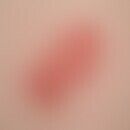HistoryThis section has been translated automatically.
W. H. Wollaston first described the presence of cystine in a stone excreted in urine in 1810 (Hoffmann 2014).
DefinitionThis section has been translated automatically.
Cystinuria is a hereditary disease in which there is a defect in transport in the proximal tubule and the epithelium of the small intestine. As a result, cystine and other dibasic amino acids such as arginine, lysine and ornithine cannot be transported (Walter 2006 / Speer 2005).
You might also be interested in
ClassificationThis section has been translated automatically.
Cystinuria occurs as a homozygous form (so-called "classical cystinuria" [Dötsch 2017]) and as a heterozygous form.
In homozygotes, a high excretion of the amino acids cystine, arginine, lysine and ornithine is found.
In heterozygotes, there are two additional variants:
- Type 1 heterozygote:
In this case, chromosome 2p16.3 is affected. The excretion pattern for the four amino acids mentioned above is normal.
- Non-type 1 heterozygote (formerly type II and III):
Non-type 1 affects chromosome 10q13, with moderately elevated levels of all four amino acids found.
(Kasper 2015)
Occurrence/EpidemiologyThis section has been translated automatically.
Cystinuria occurs with a frequency of 1: 10,000 to 1: 15,000 (Kasper 22015).
The stones formed by cystinuria are among the rarest of all kidney stones, accounting for approximately 1 % - 2 % of all kidney stones (Kasper 2015).
However, they are the most common genetic stone disease in homozygotes with a prevalence of approximately 1: 7,000. Approximately 10 % of childhood lithiasis are cystine stones (Weigert 2018).
EtiopathogenesisThis section has been translated automatically.
Cystinuria is an autosomal recessive disease. It is caused by mutations on two different chromosomes: chromosome 2 and 19, or by changes in both chromosomes (Kuhlmann 2015).
PathophysiologyThis section has been translated automatically.
The defect of membrane carrier proteins in the intestinal cells and in the proximal tubular system of the kidneys results in decreased reabsorption of the following dibasic amino acids:
- Cystine
- Lysine
- Ornithine
- Arginine
Of the above, cystine is the only amino acid that is poorly soluble. Due to the accumulation of cystine (normal value: 30 mg / 24 d), from about 300 mg - 400 mg / l, precipitation leads to the formation of typical hexagonal cystine crystals, from which cystine stonescan form in the urinary tract (Herold 2021 / Kasper 2015 / Keller 2010).
Since the cystine crystals also precipitate in the collecting tubes, tissue damage occurs there, which explains the loss of function of the kidneys.
(Kuhlmann 2015)
ManifestationThis section has been translated automatically.
In the homocytic form, recurrent nephrolithiasis usually already occurs in childhood.
In heterozygotes type 1 (see "Classification"), nephrolithiasis usually occurs after the age of 10, in non-type 1 in approx. 79 % already before the age of 10 (Dötsch 2017).
Therefore, in the case of recurrent nephrolithiasis already occurring in childhood, cystinuria should also be considered (Kuhlmann 2015).
ClinicThis section has been translated automatically.
The symptoms of cystinuria are caused by the poorly soluble cystine, through which cystine stones can form and these can cause all the symptoms of nephrolithiasis (Kasper 2015), which are:
- Occurrence of colic as soon as the stone passes a physiological constriction (such as the outlet of the renal pelvis, the vascular junction of the ureter or the ureterostium) or becomes obstructively lodged in a site of the urinary tract (Kuhlmann 2015).
Colic may result in the following symptoms:
- sudden onset of strongest swelling up and down pain in the area of the flank with radiation:
- into the upper abdomen or back in case of obstruction in the proximal part of the ureter
- into the middle and lower abdomen in case of obstruction at the pelvic junction of the ureter
- in the groin, the ipsilateral testis or the ipsilateral labia in case of obstruction in the lower part of the ureter.
- haematuria: in 90 % there is at least microhaematuria, macrohaematuria is found in 1 / 3 of the cases
- Dysuria
- bladder amenorrhea
- motor restlessness of the patient (typical symptom)
- nausea
- vomiting
- reflex subileus with retention of stool and wind (Kasper 2015 / Herold 2020)
DiagnosticsThis section has been translated automatically.
The diagnosis can be made by the amino acid pattern in the urine, which is characteristic of the disease (Speer 2005). Further examination options are, for example:
- Cystine determination in the urine with detection of hexagonal cystine crystals (preferably in concentrated morning urine; normal cystine excretion here is up to 30 mg / d).
- Analysis of excreted concretions (Kuhlmann 2015)
- Positive sodium nitroprusside test (see "Laboratory")
(Kasper 2015)
ImagingThis section has been translated automatically.
Sonography: Ultrasound is the first choice both in the acute situation of colic and in the routine examination of cystinuria (Seitz 2018).
- Detection of calculi (small stones are sometimes not visible on ultrasound).
- Renal congestion
- Ectasia of the renal pelvis (Herold 2020).
X-ray: Due to the high sulphur content, cystine stones are normally shadow-proof, but very small stones may be radiologically visualizable (Kuhlmann 2015).
For further diagnostic measures see. Nephrolithiasis.
LaboratoryThis section has been translated automatically.
Blood test: The concentration of the amino acids cystine, arginine, lysine and ornithine in the blood is inconspicuous (Speer 2005).
Urinalysis: The urine shows the typical
- the amino acid pattern typical of the disease (Speer 2005).
Further examinations can be:
- precise analysis of departed calculi (Kuhlmann 2015).
- Qualitative detection of cystine
Sodium nitroprusside test (also called burn test).
This test allows a qualitative detection of elevated cystine or homocystine levels in urine. At values of > 75 mg / l, this results in a cherry red to purple coloration of the urine (Kasper 2015 / Gressner 2019).
Quantitative detection of cystine: The quantitative determination of amino acids is performed by HPLC (High Performance Liquid Chromatography) . Through this test, differentiation between homozygotes and heterozygotes is possible. Normal cystine excretion is up to 30 mg / d. In homozygotes, amounts of 600 mg - 1,800 mg of cystine can be excreted daily.
Preferably, one should use concentrated morning urine for the test, which was previously alkalinized - to avoid precipitation of cystine - with bicarbonate to a pH- value of > 7.5 (Kuhlmann 2015 / Kasper 2015 / Seitz 2018).
Further laboratory investigations s. Nephrolithiasis
Differential diagnosisThis section has been translated automatically.
- Nephrolithiasis of other genesis (see"Types of urinary stones")
Complication(s)(associated diseasesThis section has been translated automatically.
- Increasing loss of kidney function (see also pathophysiology) (Kuhlmann 2015).
- Urinary tract infection (UTI), which can lead to urosepsis. UTI is the most important and also the most frequent complication of lithiasis (Herold 2020).
- Urinary tract infection with ureteral stenosis
- Fornix rupture due to pressure increase in the renal pelvicocaliceal system (Herold 2020)
TherapyThis section has been translated automatically.
If acute colic occurs, the first priority is analgesic treatment.
Suitable analgesics are:
- Metamizol: 1 g - 2 g i.v. is the drug of first choice, as it also has a spasmolytic and antinociceptive effect on the ureter.
- Paracetamol: 1 g i. v.
- Diclofenac: 75 mg / kg bw i. v.
- Morphine: 0.1 mg / kg bw i. v.
In a randomized study, the combination of paracetamol and diclofenac was shown to be superior to the administration of morphine for pain control.
(Seitz 2018)
General therapyThis section has been translated automatically.
The aim of the therapy is to prevent the formation of cystine stones.
Since the solubility of cystine - assuming a physiological pH- value 4.5 - 7.0 of the urine - is about 300 mg / d, (Kasper 2015) several therapeutic options arise:
- To reduce the cystine concentration in the urine, the patient should always drink high volumes of ≥ 3.5 l / d evenly distributed over 24 h. In infants, this can be achieved by using a high volume of water. In infants, this may require the insertion of a PEG tube (Seitz 2018).
- To reduce cystine excretion, a methionine-reduced diet (protein-reduced diet with < 100 g protein / d [Müller 2007]) is recommended, since methionine is metabolized to cystine in the body (Weigert 2018).
- For better solubility of cystine are possible:
- a. Alkalinization of the urine to a pH- value clearly > 7.5 with e.g. sodium bicarbonate. The dose depends on the urine pH, which should initially be measured several times a day. As a rule, the dosage is between 40 mmol - 80 mmol / d. The solubility of cystine is tripled by the alkalinization of urine (Kuhlmann 2015).
- b. ACE- inhibitors (such as captopril, enalapril). This lead to the formation of thiolcysteine disulfide and thus to better solubility of cystine. Cystine excretion can thus be reduced by about 50% (Kuhlmann 2015).
- If the above measures are not sufficient or there is already a very high excretion of cystine initially, treatment to bind cystine in the urine with the following drugs is recommended in addition to the above measures (Seitz 2018):
- a: D- Penicillamine, which forms soluble heterodimers together with cystine. With D- penicillamine, significant side effects in the form of exanthema, fever, nephrotic syndrome, etc. can occur - especially in high doses and with rapid up-dosing (Dötsch 2017). To mitigate these, a slow dose increase over several weeks is recommended (Kuhlmann 2015). Under D-penicillamine treatment, there is a decrease in vitamin B 6 serum levels, which is why pyridoxine should be regularly substituted with high doses (Weigert 2018). Dosage recommendation in cystinuria: up to 600 mg / d orally (absorption is 70%) [Hoffmann 2004].
- b: Tiopronin: Tiopronin has significantly fewer side effects than D- penicillamine. Dosage recommendation: e.g. Captimer 7 - 10 mg / kg bw / d, distributed over 3 - 4 single doses (Dötsch 2017).
- Ascorbic acid: Ascorbic acid can reduce cystine to cysteine. However, since so far the effectiveness is not exactly clarified, the therapeutic use is sometimes difficult. In addition, vitamin C degradation can lead to increased endogenous oxalate production (Weigert 2018) and thus to hyperoxaluria with the risk of calcium nephrolithiasis (see also types of urinary stones) (Kuhlmann 2015).
- Extracorporeal shock wave lithotripsy (ESWL): Cystine stones are not suitable for extracorporeal shock wave lithotripsy due to their hard consistency (Manski 2019).
Other therapeutic measures such as
- Urinary diversion
- Stone removal by
- endurological interventions
- percutaneous nephrolithotomy (PCNL)
- laparoscopic or open procedures s. nephrolithiasis.
Progression/forecastThis section has been translated automatically.
The prognosis of cystinuria is usually favorable with appropriate therapy and compliance of the patient. However, there are also cases that do not respond to therapeutic measures. In these cases, chronic kidney damage may result, including kidney failure requiring dialysis (see dialysis procedures).
(Kuhlmann 2015)
Terminal renal failure can also occur in ignorance of the diagnosis, especially after:
- unilateral nephrectomy
- Frequent surgical procedures (Weigert 2018).
Patients are cured of cystinuria by renal transplantation (Kuhlmann 2015).
LiteratureThis section has been translated automatically.
- Dötsch J et al (2017) Renal diseases in childhood and adolescence. Springer Verlag 135
- Gressner A M et al (2019) Encyclopedia of medical laboratory diagnostics. Springer Publishing 482, 1755
- Hegele A et al (2015) Urology: intensive course for continuing education. Thieme Publishers 351
- Herold G et al (2021) Internal medicine. Herold Publishers 585, 656 - 659, 769
- Hoffmann G F et al (2014) Pediatrics: basic principles and practice. Springer Verlag 478
- Hoffmann G F et al (2014) Pediatrics: principles and practice. Springer Verlag 478
- Kasper D L et al (2015) Harrison's Principles of Internal Medicine. Mc Graw Hill Education 435e- 2, 1871
- Kasper D L et al (2015) Harrison's internal medicine. Georg Thieme Publishers 435e- 1, 2303, 3111
- Keller C K et al (2010) Practice of nephrology. Springer Verlag 85, 87 - 88
- Kuhlmann U et al. (2015) Nephrology: pathophysiology - clinic - renal replacement procedures. Thieme Verlag 568, 598 - 599
- Manski D (2019) The urology textbook. Dirk Manski Publishers 267 - 272
- Müller M J et al (2007) Nutritional medicine practice: methods - prevention - treatment. Springer Verlag 263
- Seitz C et al. (2018) S2k guideline on the diagnosis, therapy and metaphylaxis of urolithiasis (AWMF register number 043 - 025).
- Speer C P et al. (2005) Pediatrics Springer Medizin Verlag Heidelberg 132
- Walter K (2006) Casebook physiology: 75 cases active edit. Thieme Verlag 54
- Weigert A et al (2018) Genetic kidney stone diseases. Medical Genetics (30) 438 - 447
Disclaimer
Please ask your physician for a reliable diagnosis. This website is only meant as a reference.




